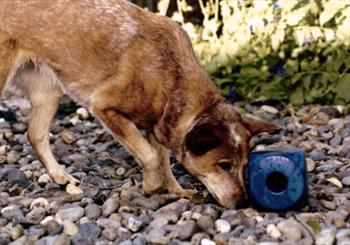My Australian Cattledog, Zoe, was pretty cute, but when it came to brain power, she was no match for her little blue neighbor —a common scrub jay. This three inch tall feathered sneak has her number. Every day, he would lie in wait and then steal bits of her coveted meal right from under her nose. Here’s how it would happen:
It’s breakfast or dinner and Mr. Scrub Jay knows. He hears the call of dog food rattling in Zoe’s food-dispensing toy. She’s carefully sucking the kibbles up as they dribble out onto the ground, but he’s sure she’ll soon make a mistake. Then he sees it. She’s missed one. And then another. Clever eyes watch as her distance from the loot increases. Wait….wait….wait…. Go!
He glides down, and wisks the kibble away over the fence into the next yard. Minutes later he’s back for another go.
Poor Zoe. Outsmarted by a creature with a macadamia nut-sized brain. But dumb Zoe? Not quite. It turns out these backyard birds can put even humans to shame with some of their mental feats.
Amazing Memory
While we humans are frantically wondering where we misplaced our one set of keys, scrub jays are artfully cataloguing thousands of stashed items. According to Nicola Clayton, who studies animal cognition at Cambridge University in England, “Some species of jays are known to cache up to 11,000 items per year. They hide items in crevices in trees or bury the items in the ground and then cover them with a leaf.”
These little masterminds not only know where they hid the loot, they also know what’s in each store. Clayton and her colleague Anthony Dickinson should know. They tested this for themselves. They provided scrub jays with both peanuts and dog kibble, which the birds promptly cached. Later, they pre-fed either peanuts or kibble and then let the birds retrieve their stores. Those who’d had their fill of peanuts raided their kibble caches. Those who’d tanked on kibble went for the peanuts. This trend held true even if the prefeeding and recovery occurred five days later. Which goes to show that it takes more than five days to make a jay forget.
But it doesn’t stop there. The two researchers found that jays also know when they cached each store. In a 1999 article published in Nature, Clayton and Dickinson report that they gave perishable waxworms and nonperishable peanuts to the scrub jays to cache and later recover. The birds preferentially searched for their favorite food, wax worms, if they had just recently cached them, but rapidly learned to avoid wax worms after longer intervals during which the worms had rotted. After these longer intervals, they searched for peanuts instead.
To be sure that the jays were remembering the specific cache site rather than detecting the specific type of food through smell or through some visual cue, Clayton and company played a dirty trick. They pilfered the caches, removing all the stored goodies. The jays still went to the to waxworm sites when caching had been recent and to peanut sites when caching had occurred several days earlier. And, oh were they angry when their found their booty burgled.
Stocking up for Survival
It seems surprising that an every-day bird could be so brilliant. The scrub jays remember not only what and where, but how long ago they’ve stored different items.
To an ecologist, the reason for their brilliance is clear. Says Clayton, “Scrub jays depend on accurately recovering their caches for survival. They do it for a living.”
Interestingly enough, the birds had to learn that food such as waxworms degrade after long intervals. A separate set of scrub jays whose rotten waxworms were secretly replaced with fresh ones after long intervals, never learned that wax worms go bad. These birds recovered waxworms first whether they’d cached them the same day or many days earlier.
This finding fits perfectly too. “Scrub jays cache many items all year round during different seasons,” explains Clayton, “so rather than being born with a rule, it’s important for them to be able to adapt. For instance during the winter, items may not be that perishable whereas during the summer, they may need to learn that insects won’t last long so they’d better eat them soon.”
As if caching itself wasn’t a big enough strain on the intellect, caching birds have another factor to deal with — theft. Stores left too long or filled in the midst of prying eyes are prizes waiting to be pilfered. Scrub jays quickly learn to cache in secrecy. Unfortunately for Zoe, some also develop into shrewd spies and crafty criminals.
For their latest findings on Scrub Jays, go to:
The Prospective Cognition of Food Caching and Recovery by Western Scrub Jays
The Rationality of Animal Memory: Complex Caching Strategies of Western Scrub Jays
San Francisco Chronicle December 2000




